Content licensed under Creative Commons
Source: NRKbeta.no http://nrkbeta.no/2013/01/15/nordlandsbanen-minute-by-minute-season-by-season/
The Norwegian Broadcasting Corporation (NRK) has made another spectacular minute by minute documentary, this time recording Norway’s northenmost railway linking Trondheim and Bodø. We’ve recorded it four times — once for every season, giving truly unique footage of this ten hour ride.
You can watch it on the web, but we have also made everything available for you to download in full HD — and licensed it with Creative Commons so that you can edit, remix and share!
This is an example of what you can make with these files:
The Nordland Railway (‘Nordlandsbanen’ in Norwegian) celebrates its 50th anniversary this year. The railway is 729 kilometers long, and passes thorugh spectacular scenery, varying from the fjord area around Trondheim in the south, through beautiful valleys, over mountains and along fjords before crossing the Arctic Circle at Saltfjellet and descending down to the coastal city of Bodø.
Clik here to view.
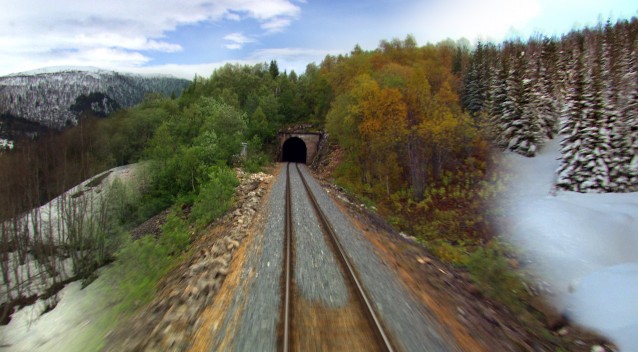
Recordings from both winter, spring, summer and autumn makes for pretty scenes such as this.
Following the success of the world’s longest live documentary, Hurtigruten minute by minute, the Telemak Canal and Bergensbanen minute by minute, the Norwegian Broadcasting Corporation set out to film the Nordland Railway as well. This time, though, we had to think up a way to show the contrasts one can encounter along the route; the weather, colours and climatic conditions.
The solution was to film the journey once every season, to show the different weather conditions and the great changes in nature’s expression from summer to authumn, and winter to spring.
Clik here to view.
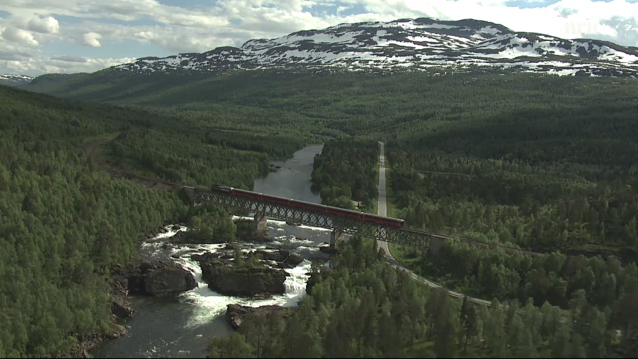
The Nordlandsbanen passes through spectacular landscape. This is a freeze frame from the television programme.
We have thus recorded the journey four times, with the idea of combining the four seasons in both a regular, 10 hour long, TV documentary, and a version for web where the audience can mix their own version. Let us show you an example of the result:
Recording
The recording was done using a SonyXDcam, placed in the front of the Di. 4 locomotives used on Nordlandsbanen. In addition we used Canon XF 302 for some side view-shots and interviews, in addition to GoPro Hero 2 and a Sony Handycam for some effect shots.
Since NSB Di. 4 is a rather unstable camera platform with a lot of vibrations, we used a special image stabilizing lens from Canon, with the very cryptial name of HJ15ex8.5B KRSE-V. For aerial shots, during the summer, we used NRK’s own Cineflex V14.
Clik here to view.

Thomas Hellum og Jon Ståle Carlsen from NRK mounts the forward-facing camera before the recording of winter along the Nordlandsbanen, 23 February 2012. Photo: Sindre Skrede/NRK
Syncing the files
Even though the Norwegian State Railway managed to keep the schedule on each of our recorded trips, the four journeys differed in position at any given time. The train will, for example, not enter a station at the exact same second in both June and March, and cannot keep the exact same speed at all times. In other words, we had to synchronize the video files in order to make the train appear to be at the same place at the same time in every video stream.
The GPS position of the train was logged continuously on each trip, with an interval of 1 Hz. Deciding to use the summer clip as the master, we used Microsoft Excel to interpolate the GPS data to 25 Hz, to match the video frame rate of 25 frames per second. This 25 Hz GPS data was then written to a PostgreSQL database.
We then wrote a script which asked the database to give us the time for when each of the other seasons were at the same position as the Summer recording. This gave us a long list of time codes, near 36 000. Using Adobe After Effects, we were then able to manipulate the speed of the winter, autumn and spring-recordings with the effect “time remap”, to match the speed and position of the summer recording.
Image may be NSFW.
Clik here to view.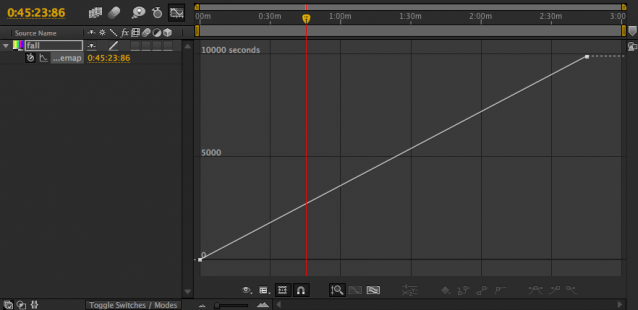 This is a screenshot of the autumn recording before we adjust it to match the speed of the summer recording. We see that the time is linear, meaning one frame in = one frame out. There is also only two keyframes: at the start and the end of the video. Adobe After Effects enables us to copy the keyframe data as plain text, and if we do that, this is what we end up with:
This is a screenshot of the autumn recording before we adjust it to match the speed of the summer recording. We see that the time is linear, meaning one frame in = one frame out. There is also only two keyframes: at the start and the end of the video. Adobe After Effects enables us to copy the keyframe data as plain text, and if we do that, this is what we end up with:
Adobe After Effects 8.0 Keyframe Data
Units Per Second 90
Source Width 1920
Source Height 1080
Source Pixel Aspect Ratio 1
Comp Pixel Aspect Ratio 1
Time Remap
Frame seconds
0 0
892026 9911.4
End of Keyframe Data
The data of interest here is the values under “frame” and “seconds”. Frame denotes which frame number is the keyframe, and seconds denotes what time in the recorded video that is to be shown at that specific frame.
You might have noticed we use 90 frames per second, as opposed to the original 25 that we recorded. Adobe After Effects does not support time lines over three hours, but does, however, support up to 99,99 frames per second. By speeding up the video, we are able to keep our time line under three hours, and avoid splitting our recording over several time lines.
What we need to do is tell After Effects when to slow down and when to speed up the recording. Using the position data we created earlier, we can generate new keyframes:
Adobe After Effects 8.0 Keyframe Data
Units Per Second 90
Source Width 1920
Source Height 1080
Source Pixel Aspect Ratio 1
Comp Pixel Aspect Ratio 1
Time Remap
Frame seconds
990 0.0
990 1.0
—– —–
3600 82.0
3675 83.0
3761 84.0
3841 85.0
3927 86.0
4010 87.0
4089 88.0
4176 89.0
4251 90.0
4341 91.0
4420 92.0
—– —–
3201886 35380.0
3201886 35381.0
End of Keyframe Data
(Originally this creates over 32000 lines, so we have shortened the list substantially.)
Having pasted the new keyframes, our timeline will look like this:
Image may be NSFW.
Clik here to view.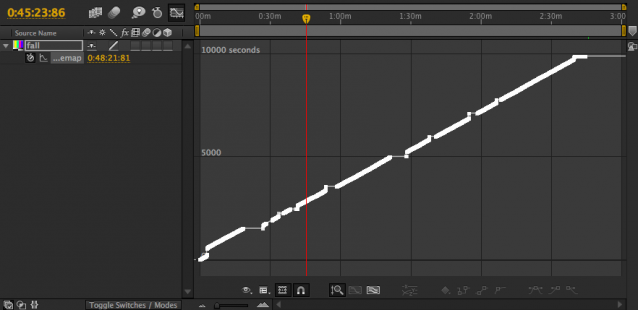 Time still goes on, but in this case it has over over 32 000 keyframes telling After Effects when to stop (horizontal lines) or jump (vertical lines) in time.
Time still goes on, but in this case it has over over 32 000 keyframes telling After Effects when to stop (horizontal lines) or jump (vertical lines) in time.
Rendering the three, time remapped seasons took over 20 hours each. They were still 90 frames per second, however, but using Apple Cinema Tools we were able to reduce this to the original 25 frames per second — without another round of rendering.
The result can be seen below: we are able to run the four seasons at the same speed, giving the impression that the train is at the same place at the same time.
Sharing
The TV programme can be seen at our website http://nrk.no/nordlandsbanen, where we’ve also coded a beta version of a video mixer, which enables you to view whatever season you want, or watch two seasons at the same time.
Clik here to view.
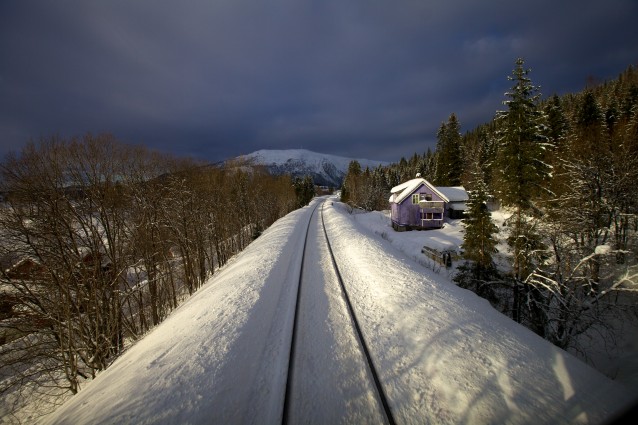
Beautiful skies over the Nordlandsbanen, when we recorded the journey 23 February 2012. Photo: Sindre Skrede/NRK
Just like we shared Bergensbanen, Flåmsbanen, Holmenkollbanen, Telemarkskanalen, and the 134 hour long Hurtigruten minute by minute-programmes, we do of course share the Nordlandsbanen as well. We give you all four seasons, already synchronised, in addition to the GPS data for each trip. The files can be downloaded via BitTorrent:
| Nordlandsbanen winter |
| Nordlandsbanen spring |
| Nordlandsbanen summer |
| Nordlandsbanen autumn |
| GPS-data |
| … and here you can take a look at our beta video mixer |
Clik here to view.
Clik here to view.
Clik here to view.
Clik here to view.
Clik here to view.